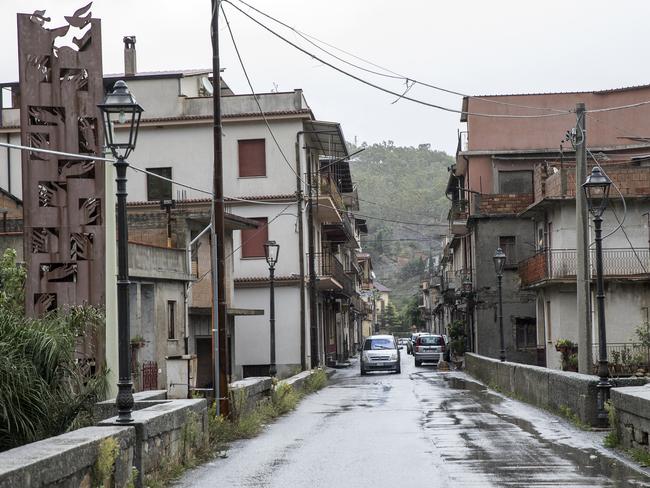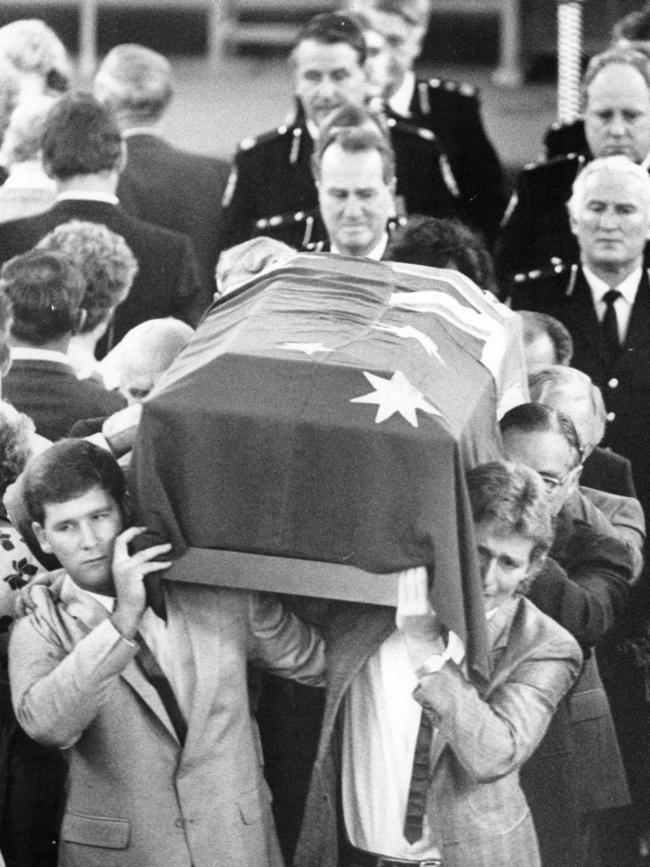The mafia family clans that spread into our suburbs
The murder trial of NCA bombing accused Domenic Perre has heard evidence of Calabrian ties from a small Italian village reaching SA.

Police & Courts
Don't miss out on the headlines from Police & Courts. Followed categories will be added to My News.
At the foot of the sprawling Aspromonte mountain ranges, deep in Italy’s rustic heart, lies the picturesque Calabrian town of Plati.
The town is renowned for its bread but, behind the beauty, is a sinister history linked to vicious mafia clans whose blood and drug-stained tendrils stretch across the globe in a web of organised crime.
The mafia’s intricate ties can be traced from Italy to the fruit groves, small towns, businesses and beachside suburbs of South Australia, according to a prominent academic.
The seven names which an Italian magistrate and historian concluded were linked to the mafia are common around SA – Sergi, Barbaro, Trimbole, Romeo, Nirta, Alvaro and Perre.

They belong to people proud of their heritage and of their legitimate professions.
People who the Supreme Court heard should not be thought of as guilty of any criminal association just because of a last name.
Essex University academic Dr Anna Sergi said that the research in Italy and abroad showed links remain between the culture of the old country and the families who moved to Australia
Giving evidence in the trial of Domenic Perre, Dr Sergi said the tendrils of organised crime had spread from Plati into Australia.
Perre has pleaded not guilty to the murder of Detective Sergeant Geoffrey Bowen and attempted murder of lawyer Peter Wallis in the 1994 NCA bombing.
The trial, before Justice Kevin Nicholson, has already heard from undercover police and is expected to hear from prison informants.
Dr Sergi’s evidence, which was heavily criticised by Perre’s legal team, was presented to the court in an effort by prosecutors to establish that the now 64-year-old was motivated by revenge when they allege he sent a bomb to the NCA’s office in Waymouth Street, city.
But the academic’s evidence extended beyond the mindset of one man and to the question of whether the thousands of people who migrated from Italy to Australia in the 1950s brought more than just the hopes of a new life.

Plati
Before 1951, Plati was growing and its population on the threshold of 9000.
But a flood in October of that year devastated the area and led to more than half the population fleeing.
Many went to northern Italy but still more left for the enigmatic shores of Australia.
Dr Sergi said the mass exodus led to chain migration, tying the areas where the new arrivals laid down roots to the old country.
“The importance of the clans from Plati to Australia is absolutely disproportionate compared to other clans,” Dr Sergi said.
“There are clans from all over Calabria in Australia but the importance of the Plati ones is one of the few certainties I have in the structure of the mafia.”
The people of Plati lived in a unique geographical and social situation, cut off from the world for centuries. Reading verbatim from Dr Sergi’s report tendered in court, prosecutor Sandi McDonald QC said: “The man from Aspromonte is often characterised as rude, tenacious, stubborn, strong, a true man of the mountain.
“The villages in the Aspromonte, especially those on the Ionian Sea, are particularly known for being the most traditional in the Calabrian cohort.”
From that sense of isolation, the families of Plati turned away from the government with its political heart in Rome and its business brain in the north and looked inward.

Honourable Society
The same factors that gave rise to the Sicilian La Cosa Nostra and the Camorra in Naples led to the birth of the ’Ndrangheta, or society of honourable men, in Calabria.
Family became the primary unit. Trust lay with the family and the broader community but government on the other side of the country was to be considered with suspicion.
Dr Sergi said what emerged from the isolated mountain ranges of Calabria, the citrus groves of Sicily and the rapidly industrialising neighbourhoods of Naples was a set of behaviours that became what is now labelled as mafia.
“So, marrying within each other’s families, the use of omerta, the reluctance to talk to authorities, the control of territories, particular interests in certain industries, intimidation and the willingness to get close to the political machine are well established activities of mafia clans in Italy and elsewhere,” she said.
“Aspromonte culture is very bond of family ties. The mafia version of this is that you only trust family; you cannot trust anyone else and definitely not the authorities.”
Dr Sergi said the ’Ndrangheta relied on a “black pedagogy” – the raising of children to believe in the values of the group rather than society.
But unlike their Sicilian brethren from across the Messina Strait, Dr Sergi said the ’Ndrangheta clans only interact with each other if they are allied or in conflict.
“They do not have to seek permission for their business endeavours,” she said.
But what the clans have in common is their adherence to a culture that comes directly from their Calabrian roots.
“Mafia culture has often been studied as a set of behaviours profoundly entrenched in the territory of origin,” Dr Sergi said, comparing the mindset to some forms of extremism.
“What happened in Australia, and in Adelaide, Canberra, Melbourne and Griffith in particular, is that these families and clans tended to stick together for reasons that have to do with migration, not necessarily ’Ndrangheta.”

Mafia Down Under
In Australia, the NSW farming town of Griffith became the undisputed heart of the Calabrian mafia.
“If there was a problem anywhere else in Australia that could not be solved by the clans, you really had two choices,” Dr Sergi said.
“Either you call on the Griffith families or you ask them to come to you, to liaise between the families.
“In a sense, the Plati families in Griffith are the so-called roof of the ’Ndrangheta everywhere else.”
Dr Sergi said a document outlining a ’Ndrangheta initiation ritual was found in SA in 1987.
“The ’Ndrangheta is very complex but all these rituals were induction ceremonies and they have been found in different places,” she said.
The criminal activities of any of the clans would be dependant on their circumstances.
“The whole point of the mafia is that they adapt to territories,” Dr Sergi said. “The Calabrian mafia today handles mostly cocaine. In Australia, because of the nature of the drug trade, they might handle methylamphetamine, amphetamines and the rest.”
At the heart of the criminal enterprise are the ties that bind a family together.
“Generally, these clans tend to stick together, marry with one another, keep the lineage intact and form what is known as a locale, which is a unification of three to six families,” Dr Sergi said.


’Excellent Murders’
A report by the former chief prosecutor of Reggio Calabria labelled the death of Det-Sgt Bowen an “excellent murder”, a term used in Italy to describe attacks by organised crime groups on high-profile targets, including politicians, judges and police.
Dr Sergi told the court that the report and other Italian documents stated the NCA bombing ranked among the disappearance of politician and anti-drug campaigner Donald Mackay and the assassination of assistant Australian Federal Police commissioner Colin Winchester.
Mr MacKay, 43, disappeared from the Griffith Hotel carpark in July 1977 after buying a cask of wine.
Near where he was last seen, police found several spent bullets, drag marks and hair as well as blood splashed on the ground.
He is presumed to have been murdered but the crime has never been solved.
Hitman James Frederick Bazley, whose aliases included “Iceman” and “Machine Gun”, was jailed for nine years for conspiracy to murder Mr Mackay but no one has been charged with the murder.
The Woodward Royal Commission concluded that Mr Mackay, who owned a furniture store, had been murdered by a contract killer on the orders of members of the Barbaro, Trimbole and Sergi families.

Mr Winchester was shot twice in the head on January 10, 1989, as he pulled up to his Canberra home. He became the most senior police officer in Australia to be murdered.
David Eastman, an economist who had made threats towards Mr Winchester, was found guilty of his murder but had the verdict overturned on appeal. In 2018, he was found not guilty after a lengthy retrial, which led to a $7.02m payout for wrongful imprisonment.
Dr Sergi said the ’Ndrangheta still operating in Calabria had, in 1994, decided to cease using murder as a way of intimidating authorities.
The court also heard that “no person of Calabrian origin has ever been convicted of the murder” of either man.
Contentious Evidence
Andrew Culshaw, for Perre queried where Dr Sergi’s primary evidence came from if the organised crime groups did not keep written records.
Mr Culshaw also questioned a recent social media post by the academic, claiming it insinuated the mafia had influence over the Victorian Court of Criminal Appeal.
He argued the academic’s conclusions about the spread of Calabrian organised crime were undermined by her use of terms such as “maybe”, “it would depend” and “everybody is different”. “ (Dr Sergi’s report is) more a theoretical essay and one has to read into it what the assertions are which might give it relevance in this case,” Mr Culshaw said.
“The inaccuracy and unreliability of Dr Sergi’s sources render the value of her study questionable.”
Ms McDonald said the matter was not as clear cut as Perre’s legal team sought to make it seem. “No one is suggesting it is 100 per cent black and white,” she said. The hearing continues later this month.


